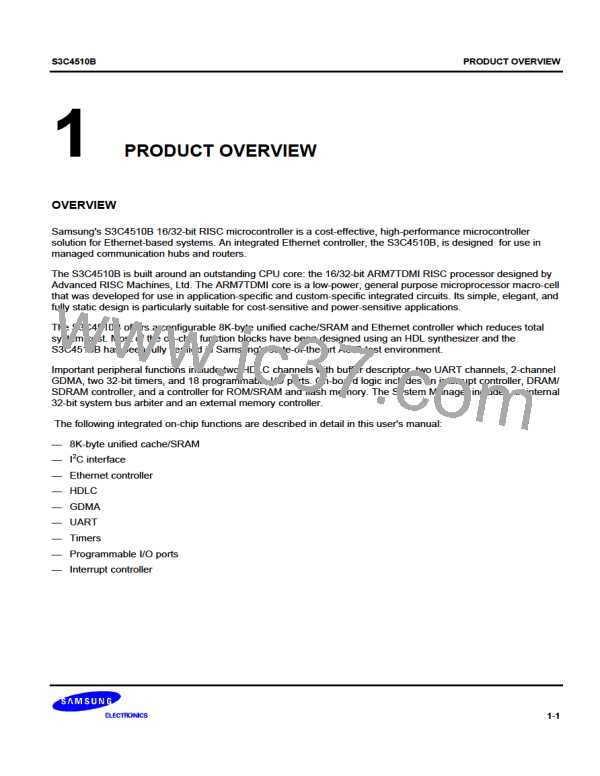ETHERNET CONTROLLER
Error Signalling
S3C4510B
The error/abnormal operation flags asserted by the MAC are arranged into transmit and receive groups. These
flag groups are located either in the transmit status register (Tx_stat) or the receive status register (Rx_stat). A
missed packet error counter is included for system network management purposes.
Normally, software does not have enough direct control to examine the status registers directly. Therefore, the
BDMA engine must store the values in system memory so that they can be examined there by software.
Reporting of Transmission Errors
A transmit operation terminates when the entire packet (preamble, SFD, data, and CRC) has been successfully
transmitted through the MII without a collision. In addition, the transmit block detects and reports both internal
and network errors.
Under the following conditions, the transmit operation will be aborted (in most cases).
Parity error
The 8 bits of data coming in through the BDII has an optional parity bit. A
parity bit also protects each byte in the MAC transmit FIFO. If a parity error
occurs, it is reported to the transmit state machine, and the transmission is
aborted. A detected parity error sets the TxPar bit in the transmit status register.
Transmit FIFO underrun
No CRS
The 80-byte transmit FIFO can handle a system latency of 6.4bi (640 bit times).
An underrun of the transmit FIFO during transmission indicates a system
problem (namely, that the system cannot keep up with the demands of the
MAC), and the transmission is aborted.
The carrier sense signal (CrS) is monitored from the beginning of the start of
frame delimiter (SFD) to the last byte transmitted. A "No CrS" indicates that CrS
was never present during transmission (a possible network problem), but the
ransmission will NOT be aborted. Note that during loop-back mode, the MAC is
disconnected from the network, and a "No CRC" will not be detected.
Excessive collision error
Late collision error
Whenever the MAC encounters a collision during transmit, it will back off,
update the "attempt counter," and retry the transmission later on. When the
attempt counter reaches 16 (16 attempts that all resulted in a collision), the
transmission is aborted. This indicates a network problem.
(Transmit out of window collision)
Normally, the MAC would detect a collision (if one occurs) within the first 64
bytes of data that are transmitted, including the preamble and SFD. If a collision
occurs after this time frame, a possible network problem is indicated. The error
is reported to the transmit state machine, but the transmission is NOT aborted.
Instead, it performs a back-off, as usual.
Excessive deferral error
During its first attempt to send a packet, the MAC may have to defer the
transmission because the network is busy. If this deferral time is longer than 32K
bit times, the transmission is aborted. Excessive deferral errors indicate a
possible network problem.
7-60

 SAMSUNG [ SAMSUNG ]
SAMSUNG [ SAMSUNG ]